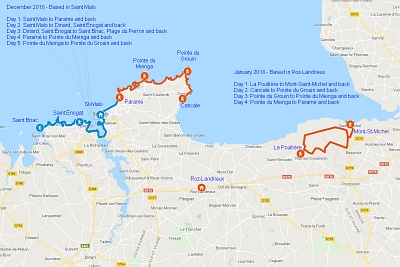GR34: Saint-Malo and Pays de Dol
(vero;2024-May-15)
We have two galleries so far:
- The first one includes pictures taken during several stays in Saint-Malo and Roz-Landrieux (where we stayed for one week in January 2018). Roz-Landrieux is located in the Pays de Dol, not far from the Mont Saint Michel (one of our favourite places in France) and we are lucky to have family in Saint-Malo, which means we are often there.
- We have a dedicated gallery for Saint-Malo and its neighbours Saint-Servan and Dinard, with more pictures to be added as time will pass.
Many pictures have been taken in winter and are proof that the weather can be very nice in this season with the added bonus of hardly a soul around. Of course, we had also cloudy and rainy skies but those are the days when we take the time to visit towns and the hinterland. Brittany in winter? Highly recommended!
Saint-Malo and Roz-Landrieux
Saint-Malo and its neighbours Saint-Servan and Dinard
Want to read more? Go on to GR34: Pays de Saint-Brieuc or go back up to Along Brittany's Coastal Path
$ updated from: Along Brittany's Coastal Path.htxt Mon 28 Apr 2025 14:55:37 trvl2 — Copyright © 2025 Vero and Thomas Lauer unless otherwise stated | All rights reserved $































